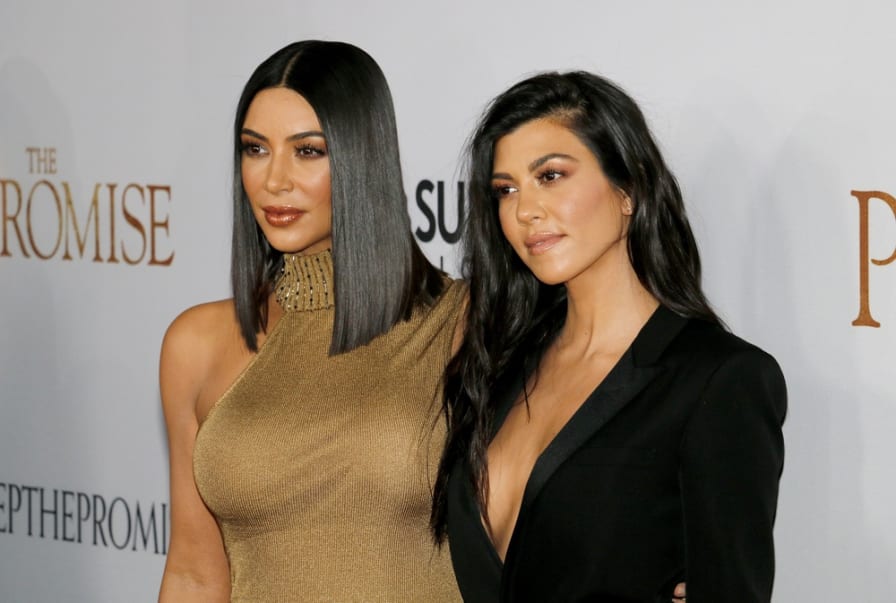Why Kourtney Kardashian’s PRP Injections For Hair Loss Are The New Vampire Facial
Six years after Kim Kardashian made the “vampire facial” famous, her sister Kourtney tried a similar technique on her scalp to reverse hair loss. Do platelet-rich plasma injections for hair loss live up to the hype? The AEDITION asked an expert.

On the premiere episode of season 17 of Keeping Up With Kardashians earlier this month, Kim Kardashian was anything but chill when she noticed a bald spot on the crown of her older sister Kourtney Kardashian’s head. "Kourtney, you have a really big spot on the top of your head," Kim worriedly told her sister. "Kourtney, oh my god. I'm afraid for your life. Have you seen that?"
Kourtney admitted she could feel the spot, and she had a hunch as to the culprit: the sky-high ponytail she sported at the amfAR New York Gala in February 2019. “It’s a hole in my head,” the 40 year old exclaimed. “I swear it’s from my ponytail, it was so tight that I had a bump on my head like this.”
While Kim and Kourt may have been a tad bit dramatic about the extent of the damage, the mom of three made an appointment with Beverly Hills plastic surgeon Jason Diamond, MD (the same doctor behind Chrissy Teigen’s social media-documented armpit Botox), who recommended platelet-rich plasma (PRP) injections to stimulate hair growth. He explained that the reality star would need "two or three series, maybe once a month for the next three months" in order to see results, but full regrowth would be possible.
Even the most casual fan of the Kardashian clan likely remembers that Kim helped kickstart the vampire facial craze back in 2013 when she underwent the procedure during an episode of Kourtney & Kim Take Miami. The treatment involves rubbing a PRP concentration over freshly microneedled skin to promote cell turnover and collagen and elastin production. The result? Immediate and long term glow.
Similar logic applies to PRP hair loss treatments. The platelet-rich plasma is injected into the scalp to repair damaged hair follicles and encourage fuller, thicker hair growth. And while Kourtney was treating a relatively mild incident, the procedure can be used as a remedy for both male and female pattern baldness and hair loss.
“In males, hair loss often presents itself as a receding hairline, while in females, it usually presents itself as thinning hair,” says dermatologist Sapna Palep, MD, of Spring Street Dermatology in New York City. “Male pattern baldness is a combination of genetics and the male hormone dihydrotestosterone. The cause in females can be multifactorial.”
As Dr. Palep explains, causes of hair loss in women can range from telogen effluvium (temporary hair loss) induced by extreme stress (think: surgery, emotional trauma, illness, weight loss) or certain medications (i.e. oral contraceptives, Accutane) to androgenetic alopecia (a.k.a. female pattern hair loss), which is often genetic.
But that’s not all.
“Autoimmune disorders — like lupus, thyroiditis, and alopecia areata — can all contribute to hair loss in women, along with polycystic ovary syndrome, which is hormonal in nature,” she shares. “Skin conditions like psoriasis or seborrheic dermatitis can cause increased hair shedding depending on severity, and traction alopecia causes areas of hair loss as a result of pulling on the hair — like with tight ponytails or braids.”
With so many potential culprits, it’s no surprise that Dr. Palep calls female hair loss a “common condition” she encounters at her practice, and PRP has become one of her go-to treatments.
“PRP treatments are a great way to treat female pattern baldness. It has a very low side effect profile compared to other treatments and is highly effective,” she explains of the three-step process. “Blood is drawn from the patient, processed for platelet extraction (growth factors), and then injected into the scalp. A typical protocol is three treatments spaced a month apart and then every six months thereafter for maintenance.”
While completing the initial series and staying on top of the maintenance schedule is necessary for full results, Dr. Palep says a patients usually see a “noticeable improvement” after the second treatment. “I typically tell patients to avoid blood thinners prior to treatment,” she explains. “And the only downtime is due to bruising for 24 to 48 hours with mild pain.”
While the injections alone yield good results, they can also be employed to complement other hair loss treatments. “PRP can be used in conjunction with oral spironolactone in women or oral finasteride in men, topical minoxidil, and supplements like Nutrafol in both men and women,” Dr. Palep says.
So, whether you’re a reality star with an overzealous glam squad or someone dealing with any of the other causes of female hair loss, PRP injections are a promising solution with little to no downtime.
Source: https://aedit.com/aedition/kourtney-kardashian-prp-injections-to-treat-hair-loss

On the premiere episode of season 17 of Keeping Up With Kardashians earlier this month, Kim Kardashian was anything but chill when she noticed a bald spot on the crown of her older sister Kourtney Kardashian’s head. "Kourtney, you have a really big spot on the top of your head," Kim worriedly told her sister. "Kourtney, oh my god. I'm afraid for your life. Have you seen that?"
Kourtney admitted she could feel the spot, and she had a hunch as to the culprit: the sky-high ponytail she sported at the amfAR New York Gala in February 2019. “It’s a hole in my head,” the 40 year old exclaimed. “I swear it’s from my ponytail, it was so tight that I had a bump on my head like this.”
While Kim and Kourt may have been a tad bit dramatic about the extent of the damage, the mom of three made an appointment with Beverly Hills plastic surgeon Jason Diamond, MD (the same doctor behind Chrissy Teigen’s social media-documented armpit Botox), who recommended platelet-rich plasma (PRP) injections to stimulate hair growth. He explained that the reality star would need "two or three series, maybe once a month for the next three months" in order to see results, but full regrowth would be possible.
Even the most casual fan of the Kardashian clan likely remembers that Kim helped kickstart the vampire facial craze back in 2013 when she underwent the procedure during an episode of Kourtney & Kim Take Miami. The treatment involves rubbing a PRP concentration over freshly microneedled skin to promote cell turnover and collagen and elastin production. The result? Immediate and long term glow.
Similar logic applies to PRP hair loss treatments. The platelet-rich plasma is injected into the scalp to repair damaged hair follicles and encourage fuller, thicker hair growth. And while Kourtney was treating a relatively mild incident, the procedure can be used as a remedy for both male and female pattern baldness and hair loss.
“In males, hair loss often presents itself as a receding hairline, while in females, it usually presents itself as thinning hair,” says dermatologist Sapna Palep, MD, of Spring Street Dermatology in New York City. “Male pattern baldness is a combination of genetics and the male hormone dihydrotestosterone. The cause in females can be multifactorial.”
As Dr. Palep explains, causes of hair loss in women can range from telogen effluvium (temporary hair loss) induced by extreme stress (think: surgery, emotional trauma, illness, weight loss) or certain medications (i.e. oral contraceptives, Accutane) to androgenetic alopecia (a.k.a. female pattern hair loss), which is often genetic.
But that’s not all.
“Autoimmune disorders — like lupus, thyroiditis, and alopecia areata — can all contribute to hair loss in women, along with polycystic ovary syndrome, which is hormonal in nature,” she shares. “Skin conditions like psoriasis or seborrheic dermatitis can cause increased hair shedding depending on severity, and traction alopecia causes areas of hair loss as a result of pulling on the hair — like with tight ponytails or braids.”
With so many potential culprits, it’s no surprise that Dr. Palep calls female hair loss a “common condition” she encounters at her practice, and PRP has become one of her go-to treatments.
“PRP treatments are a great way to treat female pattern baldness. It has a very low side effect profile compared to other treatments and is highly effective,” she explains of the three-step process. “Blood is drawn from the patient, processed for platelet extraction (growth factors), and then injected into the scalp. A typical protocol is three treatments spaced a month apart and then every six months thereafter for maintenance.”
While completing the initial series and staying on top of the maintenance schedule is necessary for full results, Dr. Palep says a patients usually see a “noticeable improvement” after the second treatment. “I typically tell patients to avoid blood thinners prior to treatment,” she explains. “And the only downtime is due to bruising for 24 to 48 hours with mild pain.”
While the injections alone yield good results, they can also be employed to complement other hair loss treatments. “PRP can be used in conjunction with oral spironolactone in women or oral finasteride in men, topical minoxidil, and supplements like Nutrafol in both men and women,” Dr. Palep says.
So, whether you’re a reality star with an overzealous glam squad or someone dealing with any of the other causes of female hair loss, PRP injections are a promising solution with little to no downtime.
Source: https://aedit.com/aedition/kourtney-kardashian-prp-injections-to-treat-hair-loss
Check out related articles > Platelet Rich Plasma (PRP), hair loss










Comments